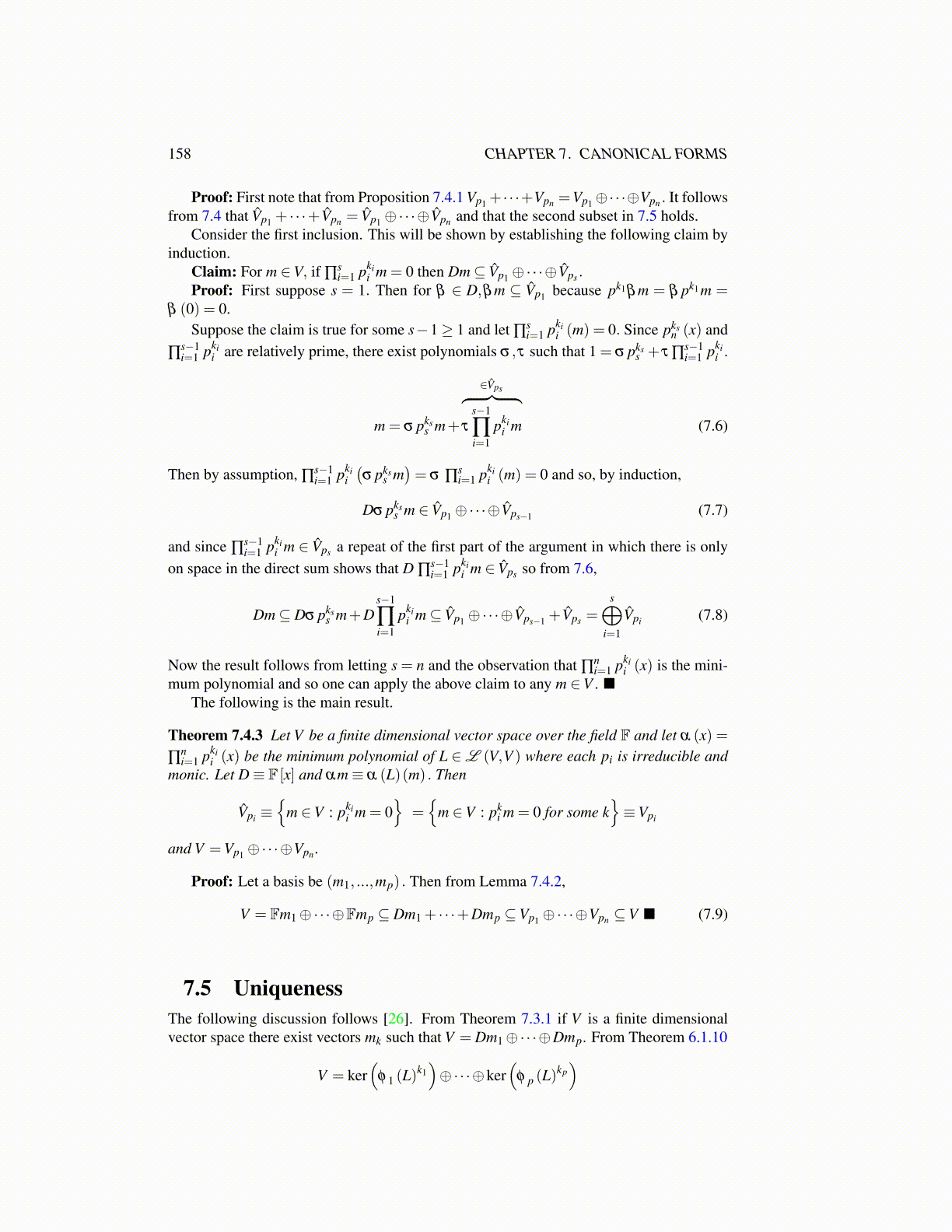
158 CHAPTER 7. CANONICAL FORMS
Proof: First note that from Proposition 7.4.1 Vp1 + · · ·+Vpn =Vp1⊕·· ·⊕Vpn . It followsfrom 7.4 that V̂p1 + · · ·+V̂pn = V̂p1 ⊕·· ·⊕V̂pn and that the second subset in 7.5 holds.
Consider the first inclusion. This will be shown by establishing the following claim byinduction.
Claim: For m ∈V, if ∏si=1 pki
i m = 0 then Dm⊆ V̂p1 ⊕·· ·⊕V̂ps .Proof: First suppose s = 1. Then for β ∈ D,βm ⊆ V̂p1 because pk1βm = β pk1m =
β (0) = 0.Suppose the claim is true for some s−1≥ 1 and let ∏
si=1 pki
i (m) = 0. Since pksn (x) and
∏s−1i=1 pki
i are relatively prime, there exist polynomials σ ,τ such that 1 = σ pkss + τ ∏
s−1i=1 pki
i .
m = σ pkss m+
∈V̂ps︷ ︸︸ ︷τ
s−1
∏i=1
pkii m (7.6)
Then by assumption, ∏s−1i=1 pki
i
(σ pks
s m)= σ ∏
si=1 pki
i (m) = 0 and so, by induction,
Dσ pkss m ∈ V̂p1 ⊕·· ·⊕V̂ps−1 (7.7)
and since ∏s−1i=1 pki
i m ∈ V̂ps a repeat of the first part of the argument in which there is onlyon space in the direct sum shows that D ∏
s−1i=1 pki
i m ∈ V̂ps so from 7.6,
Dm⊆ Dσ pkss m+D
s−1
∏i=1
pkii m⊆ V̂p1 ⊕·· ·⊕V̂ps−1 +V̂ps =
s⊕i=1
V̂pi (7.8)
Now the result follows from letting s = n and the observation that ∏ni=1 pki
i (x) is the mini-mum polynomial and so one can apply the above claim to any m ∈V . ■
The following is the main result.
Theorem 7.4.3 Let V be a finite dimensional vector space over the field F and let α (x) =∏
ni=1 pki
i (x) be the minimum polynomial of L ∈L (V,V ) where each pi is irreducible andmonic. Let D≡ F [x] and αm≡ α (L)(m) . Then
V̂pi ≡{
m ∈V : pkii m = 0
}={
m ∈V : pki m = 0 for some k
}≡Vpi
and V =Vp1 ⊕·· ·⊕Vpn .
Proof: Let a basis be (m1, ...,mp) . Then from Lemma 7.4.2,
V = Fm1⊕·· ·⊕Fmp ⊆ Dm1 + · · ·+Dmp ⊆Vp1 ⊕·· ·⊕Vpn ⊆V ■ (7.9)
7.5 UniquenessThe following discussion follows [26]. From Theorem 7.3.1 if V is a finite dimensionalvector space there exist vectors mk such that V = Dm1⊕·· ·⊕Dmp. From Theorem 6.1.10
V = ker(
φ 1 (L)k1)⊕·· ·⊕ker
(φ p (L)
kp)